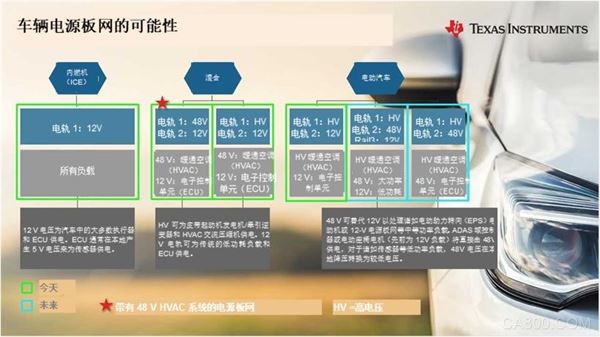With the increasing demand for autonomous driving functions, comfort, convenience, and infotainment functions, the demand for electric energy in automobiles is increasing. Today's cars have more and more sensors, actuators, and electronic control modules (ECUs) that read the sensors and control the actuators. At the same time, the increasing demand for hybrid and electric vehicles makes energy efficiency an important design goal. After all, increasing efficiency will increase the distance traveled by the vehicle.
In order to improve power efficiency, automotive design engineers are implementing high-voltage power supply boards in automobiles. The use of a higher voltage power grid not only helps to reduce the overall weight of the vehicle (for example, by reducing the weight of the wiring harness), but also does not require voltage level conversion, because the higher voltage can directly power the actuator.
Although it seems that using a single high-voltage power supply board net is the best choice, in fact, the power requirements of different actuators and ECUs are constantly changing, which prompts automotive system designers to install two to three voltage power supply board nets in the vehicle.
In this article, we will discuss the voltage power supply board network that automotive designers consider in the next-generation automotive architecture. We will also provide you with product series and resources to help you solve various technical challenges related to different power board networks.
Figure 1 shows the possibility of different voltage power supply boards in vehicles based on different vehicle types.

Use 12V power supply board net to power the control module
According to the International Organization for Standardization (ISO) 7637-2 and ISO 16750-2 standards, the traditional 12 V power supply board network has a wide voltage range. Although these requirements are unlikely to change for vehicles based on internal combustion engines, the use of 12 V in hybrid and electric vehicles may result in a reduction in the maximum voltage, especially if the 12 V bus does not have an alternator (that is, if the 12 V power supply All the power required by the board network comes from a high-efficiency DC/DC converter for stepping down from high voltage to 12V) In this case, a low-input voltage regulator can be used to implement a power management solution in the ECU.
Designers can flexibly solve various technical challenges in the control module powered by the 12V power supply board network. These control modules have a series of products that comply with automotive standards, such as power management, amplifiers, transceivers, motor drives, and smart power switches.
Responding to the challenges in the 48V power supply board network
48V power supply board net is usually used to supply power for loads that require higher power. The specific load powered by 48 V depends on the vehicle type. Regardless of the module type, the control module connected to the 48 V power supply board network will require a power management device that is efficient, high power density, and can withstand the operating voltage requirements specified in ISO 21780. If the ECU is also connected to the 12V power supply board, the module also needs to be functionally isolated. The high-efficiency multi-phase 48V gate driver with functional safety can drive 48V actuators such as belt starter generators or HVAC AC compressor modules. The need for functional safety drives the need for other diagnostic circuits such as load current sensing. In the 48V battery management system, the deployment of the 48V power supply board network also requires efficient and accurate charge status and health status management.
In order to improve efficiency, enhance power density, and achieve functional safety in 48 V power supply board grid systems, designers can use buck regulators, three-phase gate drivers, battery management systems, and a wide range of current and voltage sense amplifier product portfolios.
Maximize the high-voltage power supply board network
The battery system of an electric vehicle generates a higher voltage. High-power loads such as traction inverters and HVAC AC compressor modules are directly supplied by the high-voltage power grid. This means that the power stages used to drive these high-voltage loads need to withstand high operating voltages and require high common-mode transient immunity (CMTI). In addition, achieving a compact solution requires high power density gate drivers and power stages. The use of multiple power board networks also requires isolation between the low-voltage domain and the high-voltage domain in the control module to ensure normal operation. The use of high voltage may require design not only to meet electrical safety requirements, but also to meet functional safety requirements. The latter's requirements necessitate the realization of diagnostic functions to generate additional current, voltage and temperature sensing solutions in these systems. In addition, there is a need for a high-efficiency high-voltage battery management system that has accurate charge status and health status management and maintains better battery uniformity.
High-voltage gate drives, battery management systems, power and signal isolators, and high-speed operational amplifiers are a wide range of product portfolios. Designers can use these products to optimize and deal with efficiency, power density, functional safety and reliability challenges in high-voltage control modules .